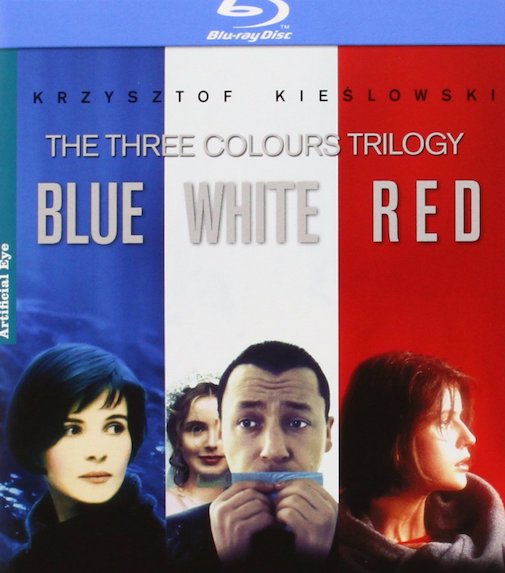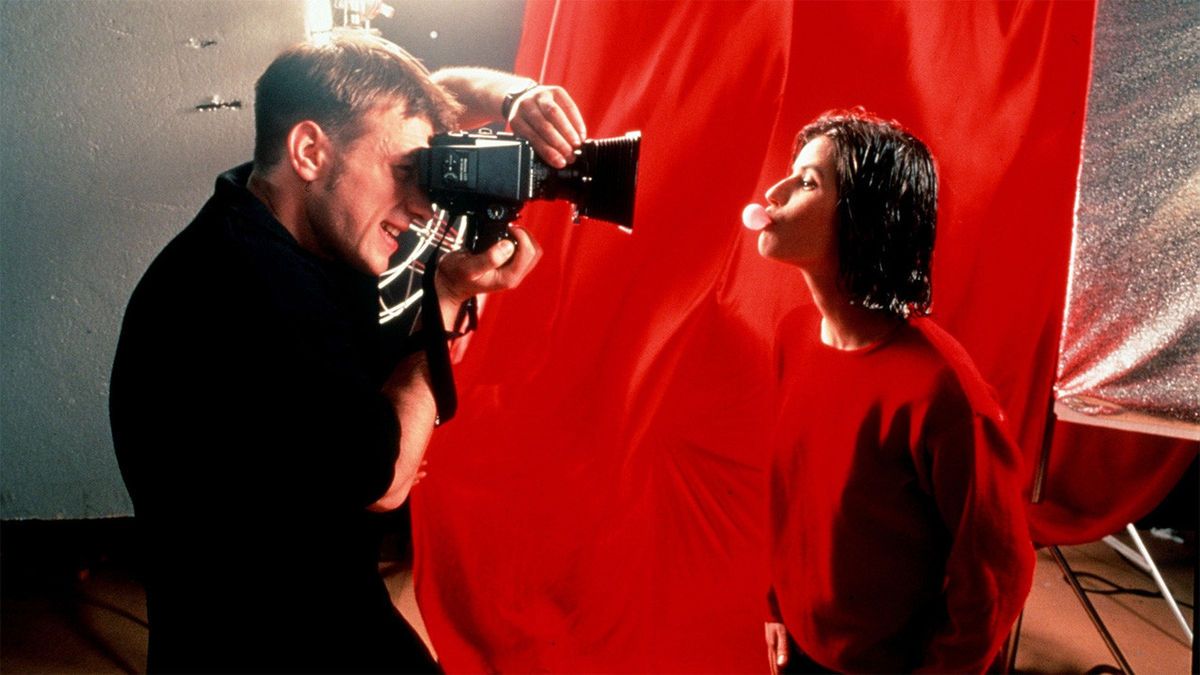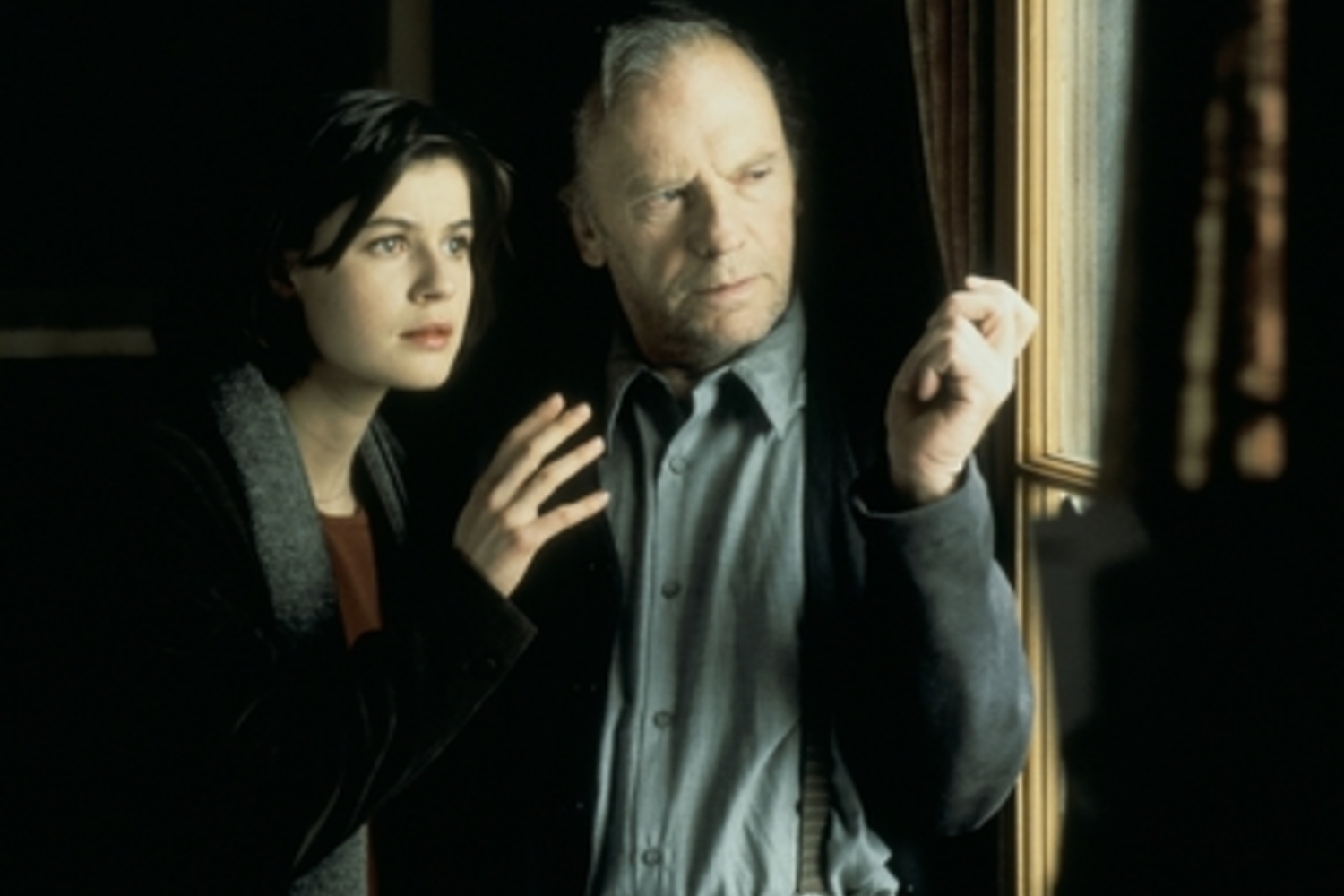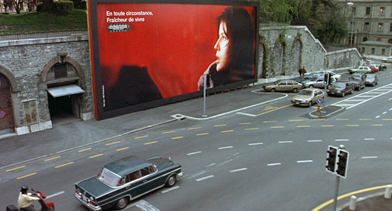"Three Colors: Red" at 25
 Saturday, November 23, 2019 at 6:30PM
Saturday, November 23, 2019 at 6:30PM  by Lynn Lee
by Lynn Lee
Transfixed. Transported. Exhilarated. These are words I don’t use lightly when I’m talking about movies, but they all apply to my reaction the first time I saw the final installment of Krzysztof Kieslowski’s Three Colors trilogy. And in large measure they still do. Even if the initial wonder has given way to a comforting familiarity, few films capture the universal human yearning for connection and kinship (or fraternité, the unifying theme of Red) as vibrantly yet delicately as this one.
I first saw Red some years after its initial release, at a special screening at the university I was attending. I went in knowing very little about the film except that the friend I went with had seen it before and spoke of it in glowing terms. He noted that in an ideal world I’d have seen the preceding chapters, Blue and White, but thought I’d enjoy Red even without having done so.
He was right.

In fact, I occasionally wonder if Blue and White – both of which I admire rather than love – suffered by comparison when I saw them later. Perhaps I’d have a different take if I’d watched the trilogy in the intended order. But I don’t think it would have altered my strong personal affinity for Red, which quickly became one of my all-time favorite films...
The narrative outline is deceptively simple: A beautiful but lonely student and part-time model named Valentine (Irène Jacob), through chance or fate, comes across a misanthropic retired judge (Jean-Louis Trintignant) with a disturbing habit of wiretapping his neighbors, leading to an unlikely friendship. At the same time, we observe one of the judge’s neighbors, a handsome young man (Jean-Pierre Lorit) whose career and romantic trajectory eerily echoes the judge’s, and wonder if the two storylines will ever intersect. Not to spoil a 25-year-old movie, but they do, in a big, even cosmic way.
And that’s perhaps what makes the film so haunting and memorable – that sense of cosmic fate, or divine mystery, in what determines whether or when people can meet or miss each other. Other movies, from Sliding Doors to Before Sunrise / Sunset have played with similar ideas, but without that brooding, supernatural, almost spooky dimension that heightens rather than diminishes Red’s emotional impact. The first time I saw it, I came away with dueling theories that the judge was God, or at least a god, and/or that he had managed to find a way to exist simultaneously in two timelines or two incarnations.

Revisiting it after many years, I was struck by how powerful that impression remains. Even as I wondered anew why I didn’t find the judge creepy, given his propensity for surveillance and for testing Valentine, I chalked it up to Trintignant’s demeanor, which shifts from forbidding to compassionate to affectionate without losing its basic inscrutability and air of omniscience. If the judge doesn’t actually control each dramatic turn of the plot, it damn sure feels like he does, all the way up to the climactic storm and the penultimate tableau of the survivors that neatly—perhaps too neatly—ties up the entire trilogy. I was also struck for the first time by the arbitrary cruelty of a fate or god that would drown hundreds of other people (plus one adorable little dog) just to bring two people together, not to mention the petty vindictiveness of killing off one unfaithful girlfriend. Red may be the warmest of the Three Colors, but that doesn’t mean it’s bereft of Kieslowski’s sardonic edge.
Any tendency to cynicism, however, fades with each fresh shot of Jacob’s face, which is as open and guileless as Trintigant’s is enigmatic. Valentine’s empathy and vulnerability are the emotional canvas of the film; it’s surely by design that the pervasive splashes of red seem most vivid when she’s in the frame, reaching their apotheosis in the iconic final shot of her profile. But my favorite image comes before that, during a moment in an emptied-out theater, when the judge takes Valentine’s hands and the warmth of her expression transfers to his, even as a storm builds outside. The scene feels elemental and profound, laden with the portent that something momentous is about to happen, yet also incredibly tender and intimate. As such, it’s a microcosm of the film as a whole, and embodies why it continues to hold a special place in my heart.

other celebrations of 1994
1994 Miscellania - Nathaniel R
The Client - Nathaniel R
Ed Wood - Anna
Four Weddings and a Funeral - Deborah Lipp
It Could Happen to You - Nathaniel R
Quiz Show - Anna
Reality Bites - Mark Brinkerhoff
Shallow Grave - Anna
Speed - Lynn Lee
Supporting Actress Smackdown -Nathaniel with special guests



Reader Comments (15)
Easily one of the great trilogies ever made. Blue is my favorite of the three while I have a soft spot for White due to its humor. All 3 films are great.
My rule: if I don’t speak the language, I don’t see the film. Thank u, next!
Very overrated and too intellectually artsy for my taste... White is by far my favorite at least there are some humor which the two other instalments lack since they take themselves sooooo seriously it's painful to watch....
It took a hell of a mind to conceive a trilogy that had not only such distinct parts but that concentrated so many of its impulses in this last film. One of the best Director nominations that Oscar made in that decade. Exquisite.
There is a scene in Red that captivates me so much: that part when the judge (Trintignant) tells Valentine (Jacob) to hold the moment and enjoy the rare shadow and light cast by the setting sun in the room. I don't know why it captures me every time -- it just does. A similar scene happened in Lee Chang-dong's Burning during the act of lovemaking, a character points to that precise moment when light and shadow play against the wall. It is like an ethereal moment in any given day. Love it.
I love Red much more than any of the films in the trilogy, plus the use of Elżbieta Towarnicka's otherworldly vocals singing Budenmayer's compositions.
Blue is my favorite. The soundtrack is amazing!
Red is a very good movie and have not seen White yet
Blue is my favorite (Binoche had the best performance of the 90's), but I love Red, too.
What a stupid comment from the person who steals online identities with Nathaniel's permission.
RBG -- I dont give people "permission" to act like assholes. I genuinely dont have the expertise, the budget, the coding skills, the time, or other to come up with a different comments section or rework the entire site to prevent people from being jerks (they'll find other ways) in the middle of awards season. Sometimes I honestly wonder how people think a website runs. It's not magic. I wish all of you impersonating other people would just stop. The comments section used to be so fun.
Cal - Blue is my favourite as well but I love Red.
Lynn - this was a great piece.
Zig - totally agreed. Sometimes being disqualifed from best foreign film has its perks (see also Pedro's Oscar for Talk to Her.
owl: That is a great moment I love, too.
Thanks for this tribute to the film in its 25th year! I love it and have fond memories of the first time I saw it: my university had (has) an on-site public cinema and they showed the trilogy on, I think, successive weeks or something like that, around the time that Red was being released. I went with a friend to each one in turn. I think Blue is the most striking in its use of faces and colours, White is funny and charmingly sour but slightly less impactful, and Red is the one that digs into your heart - it's such a great way of telling a story about how people find someone they will love. Red is my favourite, and the day it got nominated for three Oscars - including Best Directing!! - was a very sweet treat. Alas, it was only a year or so later that Kieślowski passed away, tragically too soon. But here were are, decades later, still marvelling at his filmmaking.
White is my favorite.
“Blue” is the Warmest Color. He!
That's not what I have to say about the Kieslowski trilogy.
For the love of Kathy Bates, /3rtful please stop it
And God saw that the wickedness of man was great in the earth, and that every imagination of the thoughts of his heart was only evil continually. And it repented the Lord that he had made man on the earth, and it grieved him at his heart. And the Lord said, I will destroy man whom I have created from the face of the earth; both man, and beast, and the creeping thing, and the fowls of the air; for it repenteth me that I have made them. But Noah found grace in the eyes of the Lord.
Genesis 6:5-8
And, behold, I, even I, do bring a flood of waters upon the earth, to destroy all flesh, wherein is the breath of life, from under heaven; and every thing that is in the earth shall die.
Genesis 6:17
But as the days of Noah were, so shall also the coming of the Son of man be. For as in the days that were before the flood they were eating and drinking, marrying and giving in marriage, until the day that Noe entered into the ark, And knew not until the flood came, and took them all away; so shall also the coming of the Son of man be.
Matthew 24:37-39
Exactly 8 people survived the flood in Noah’s day.
Agape Eros Philia
These films document the new birth experience spoken of in the Bible in John 3:1-5. The tears shed by the protagonists of the three films represent the conversion experience of the Christian from spiritual death to life, which the Bible describes as the circumcision of the heart, ushered in by Jesus according to the prophecies found in the Old Testament, specifically Deuteronomy 30:6, Ezekiel 36:26, and Jeremiah 31:31-34.
Paul’s description of ágape love in 1 Corinthians 13 forms the backbone of the closing chorus in Blue, and it’s this love which the three protagonists experience for the first time at the hands of their partners, who in all three films live out the experience of this unique and perfect love in relation to their other half - even if, in the case of Dominique, this love manifests itself only in the final moments of White. God sent His son to reveal His character to men, that his image might be restored in them by his power; which image is love 1 John 4:8. Patrice and Valentine are stunning examples, and I believe inspired examples, of what a true Christian is, in an age where false Christianity reigns almost universally - itself the surest sign yet that we are living in the end of days, Matthew 24:12. These films are God’s last attempt at warning those who have been led astray by the false promises of atheism ushered in over 200 years ago by way of the French Revolution. Kieslowski flips this false narrative on its head, and in the process has revealed nothing less that the reality of Christ himself, in the person of the Holy Spirit.